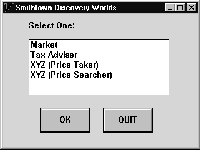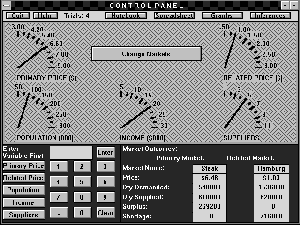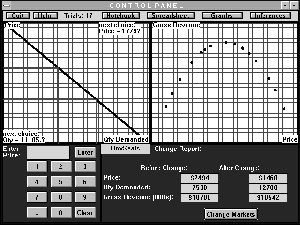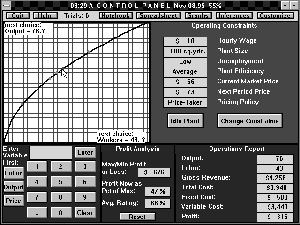Volume 10 Issue 3, 1996

Smithtown, UK
- Arnold Katz
- University of Pittsburgh and University of Bristol
Thanks to a sabbatical leave and the kind hospitality of the newly formed Institute of Learning and Research Technology, I am now maintaining a clone of the Smithtown (University of Pittsburgh, USA) Collection at a University of Bristol ftp site. Thisshould improve the programs' support, and my stay here (through to the first of August, 1997) will hopefully enable me to work more closely with those in the UK who may be interested in exploring the programs' potential for instruction and research.

Figure 1: Control Panel for the Market World
The Collection is a suite of simulation programs intended to supplement a broad range of teaching styles for the introductory microeconomics course. There are three separate units, called Discovery Worlds, whose central interfaces are illustrated in the accompanying figures. Figure 1 is the Control Panel for the Market World which students use to manipulate dials which perturb a set of demand and supply curves for related goods with changes in family income, population, number of suppliers, etc. The simulations thus become essentially a set of experiments which students can use, in self-directed study, to check on their understanding of the comparative statics of Smithtown market behavior.

Figure 2: Illustration of the Interface from the Tax Advisor World
Figure 2 from the Tax Adviser World illustrates an interface designed to enhance understanding of applications of elasticity-revenue relationships. This unit challenges students to find the optimal distribution of alternatively priced seats for an amusement tax on sports stadium admissions which the Smithtown Council hopes will provide relief for property taxes. The left hand graph pictures a demand curve for season passes for seats of different types whose properties the students can explore with before and after revenue rectangles. The right hand graph shows the revenue-price implications of experiments with alternative prices only for the starting point, which are the Box Seats. The program is structured so as to require students to find the remaining seating plans analytically, by the use of demand elasticities.

Figure 3: Starting Point for the XYZ Ltd. World
Figure 3 is the starting point for the XYZ, Ltd. World which asks students to manage a Smithtown corporation at least as profitably as its most efficient rival. Changes in market structure and the ability to manipulate operating constraints, like size of plant, deepen understanding of the profit-maximizing principles behind marginal-cost pricing, shut-down points, investment decisions, etc. The interface sets the stage for the initial explorations with the left hand graph of a labor-output production function from which the student selects operating targets under randomly varying market prices. Students learn to derive the relevant cost curves from the accumulating data, which they then substitute for the production function when making target selections as their understanding of profit-maximizing behavior increases.
Aspects of the Smithtown programs have been variously described in past issues of CHEER (Number 16, May 1992 and Vol. 10, Issue 1, 1996). The open-ended architecture of the Discovery World motif lends itself to being adaptable to a broad range of instructional approaches. The programs come with a manual (which may be freely reproduced in whole or in part, with appropriate credits to the developers) containing illustrative problem sets which have proved the most effective in courses at the University of Pittsburgh over the past several years. Students also have access to on-line tutorials which help with what experience has shown to be the more difficult problems posed by the manual.
A revision is in the works which will better exploit the possibilities of 32-bit operating systems and significantly improve accessibility to the programs' extensive record-keeping capabilities for instructional research (See the latter CHEER piece for more on this). Revisions in the program supplements, also underway, will elaborate on how Smithtown may be best used in conjunction with the WinEcon program, as our research indicates that the two approaches are highly complementary. None of these changes should, however, materially affect current uses of the programs by those who will prefer to leave things as they are.
Teaching staff in the UK interested in downloading the programs will find them at the University of Bristol anonymous ftp site: desire.ilrt.bris.ac.uk, subdirectory: /pub/smthtown. (Login as anonymous with email address password.) Smithtown, USA is similarly available at the University of Pittsburgh anonymous ftp site: ftp.pitt.edu, subdirectory: /dept/econ. There are three compressed files named smthdsk1.zip smthdsk2.zip, etc. Uncompress each onto separate diskettes and install as directed in the readme file on disk1. The program will open with the dialog box at the head of this note, permitting access to the student's choice of Discovery Worlds, running under Windows 3.X or Windows 95 with Intel 386 and higher PCs.
Questions about the program or requests for help in getting them up and running will be cheerfully (no pun intended) responded to if directed to me at Arnie.Katz@bristol.ac.uk. As I plan to be traveling about the UK in the coming months, I shall be more than happy to accept invitations to run workshops on uses of the programs and/or present findings at seminars illustrating their research potential.
References
Katz, A (1992) The Smithtown Market Module: A Discovery World Program for Introductory Economics. Computers in Higher Education Economics Review, Number 16 (May) pp 3-8.Katz, A (1996) Upping the Ante for Instructional Software: Learning How Students Learn. Computers in Higher Education Economics Review, Volume 10 Issue 1 pp 2-7

